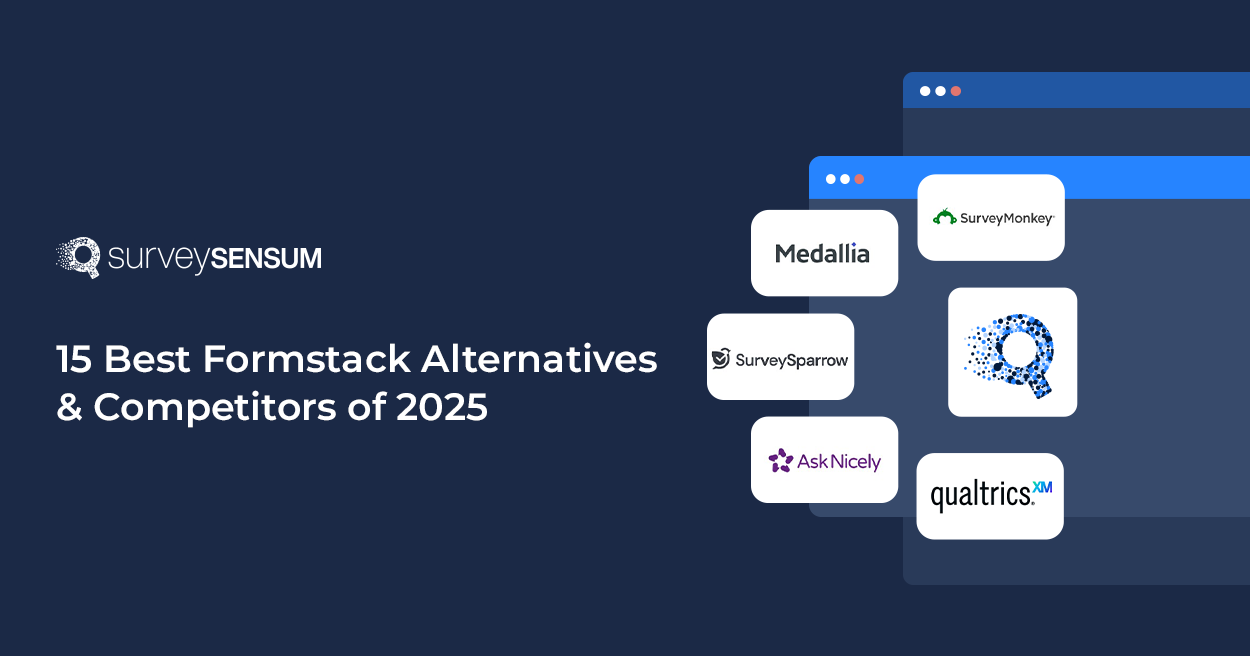
You know engaged employees are 67% more likely to be advocates for their company.
Well, these stats show a direct connection between team engagement, understanding your customers, and the success of your business. It’s like uncovering the hidden code to success!
This connection between engaged employees and customer satisfaction leads us to something transformative: the Voice of the Customer (VoC). This isn’t just about collecting data but understanding what your customers truly want and need.
And guess what? When your team understands your customers better, they’re more motivated. It’s like they see the impact they’re making, and that fires them up even more.
But how to use VoC to motivate employees, and why is it so important for them? Let’s find out!
Why Does VoC Matter for Team Motivation and Engagement?
Why Does VoC Matter for Team Motivation and Engagement?
It’s more than just numbers; it’s a game-changer in sparking motivation and engaging your team like never before. Here’s why they’re vital for igniting your team’s motivation and engagement:
1. Illuminate the Impact
Did you know that 84% of highly engaged employees believe they can positively impact their company’s success?
Your company can achieve this result, too, only if your employees understand the impact of their efforts on customer satisfaction through VoC insights; it’s like holding a backstage pass to witness the roaring applause from satisfied customers—a compelling motivator.
For instance, swift responses from your support team often lead to positive customer reviews. This direct link between positive feedback and their actions significantly boosts team morale.
2. Purpose and Accomplishment
Connect positive customer feedback to your team’s sense of purpose and accomplishment. It’s about contributing to a positive customer experience and adding meaning to their work.
For example, a customer praises your product’s user-friendly features. Sharing this feedback reinforces your team’s contribution to creating a beloved product.
3. Uncover Hidden Frustrations
VoC data acts as a detective, unveiling subtle frustrations that may be silently demotivating your team. Identifying and addressing these issues breathes fresh air into your work environment.
For example, discovering repeated customer struggles with a service aspect allows your team to overcome challenges, fostering a sense of accomplishment.
Launch VoC Surveys with SurveySensum
8 Best Practices to Use VoC to Motivate Employees
In the dynamic business realm, motivated teams are the backbone of success. But how can you transform your team into a powerhouse of creativity, purpose, and accomplishment? The answer lies in leveraging Voice of the Customer (VoC) insights.
Let’s delve into the best practices that will not only motivate but empower your team for unparalleled success.
1. Show Appreciation for a Job Well Done
Did you know employee recognition increases employee engagement by nearly 60%, leading to higher job satisfaction and productivity?
The stats highlight the significance of acknowledging good performances as a means of celebrating success within the team. Because recognition is a powerful motivator that not only boosts morale but also encourages creativity and dedication among team members, it creates a positive and appreciative work environment.
You can implement the following practices to motivate your employees:
- Public Recognition: Highlight exceptional performances openly within the team or company. You can also use team meetings or dedicated platforms to applaud exemplary efforts.
- Specific Shoutouts: Call out individuals or teams by name to spotlight their achievements. Acknowledge the specific actions or results that deserve appreciation.
- Encourage Peer Recognition: Foster a culture where team members appreciate each other’s accomplishments.
- Incorporate Creativity: Use various channels like social media, newsletters, or internal platforms to showcase achievements.
Accenture is a shining example of how appreciation and empowerment can significantly boost team performance. Accenture’s team motivation and performance success are exemplified through its appreciation and empowerment strategies.
The global professional services company’s apprentice program highlights its commitment to inclusivity. Beyond this innovative program, Accenture employees praise the company’s effective management practices and early delegation of responsibilities, fostering a culture of trust and empowerment.
2. Empowerment through Problem-Solving
Empowering employees through problem-solving entails involving them in addressing customer issues and encouraging their active participation in finding solutions.
This approach leads to more motivated employees by:
- Fostering Purpose: Alignment with company strategy and vision gives employees a sense of purpose.
- Driving Improvements: Insights from employees can lead to process enhancements and service improvements.
- Gaining Stakeholder Buy-In: Involving employees in issue resolution builds a sense of ownership and commitment.
Here’s how you can empower your employees through problem-solving:
- Align with Company Strategy: Ensure employees understand the company’s mission and goals.
- Encourage Participation: Invite employees to contribute ideas and solutions to customer problems.
- Provide Support and Resources: Equip them with the necessary tools and support to propose and implement solutions.
- Acknowledge Contributions: Recognize and appreciate their input and efforts in problem-solving initiatives.
- Feedback Loop: Establish a feedback mechanism to implement improvements suggested by employees and track their impact on customer satisfaction.
L’Oreal is a prime example of how empowering employees can fuel motivation and align them with the company’s strategy. The renowned beauty company has crafted a compelling Employee Value Proposition (EVP) that embodies its values and culture.
In 2012, L’Oreal took a proactive approach to developing a new EVP by seeking input from current employees, emphasizing a culture of excellence and a thrilling experience. This strategic alignment empowers L’Oreal employees, giving them a greater sense of purpose, especially when resolving customer issues.
3. Setup Rewards and Recognition
It is important to establish a system within a company to acknowledge and appreciate employees’ efforts and achievements.
It is important because it,
- Boosts morale and motivation among employees.
- Fosters a culture of appreciation and acknowledgment.
- Reinforces desired behaviors and outcomes.
- Enhances employee engagement and job satisfaction.
Setting up rewards and recognition involves:
- Identifying Top Performers: Collect customer feedback to spot employees consistently delivering exceptional service.
- VoC-Linked Rewards: Connect recognition directly to customer satisfaction metrics using VoC insights.
- Motivational Tools: Use social media shoutouts, R&R sessions, and team meetings to boost motivation and acknowledge outstanding work.
For example, as a global streaming giant, Netflix exemplifies top-notch employer branding and effective recognition strategies. Netflix strategically leverages social media button, notably Instagram, to spotlight employee stories and internal campaigns, expanding its brand narrative and engaging potential talents.
4. Showcase Impactful Training Techniques
Utilize customer support calls as a rich source of training material for your employees. These calls provide real-life scenarios that are invaluable for training purposes.
Because it provides,
- Practical Learning: Real-life scenarios offer practical insights into actual customer interactions.
- Empathy Building: Exposure to genuine customer conversations fosters empathy among team members.
- Enhanced Problem-Solving: Dealing with real situations improves employees’ problem-solving skills.
So, here’s how to do it for your business:
- Call Transcriptions: Transcribe customer calls to create reference materials for training sessions.
- Role-playing Exercises: Engage employees in role-playing activities based on actual call scenarios.
- Case Study Discussions: During training, analyze and discuss successful call resolutions as case studies.
- Feedback Integration: Incorporate customer feedback into training sessions for practical insights.
- Interactive Training Modules: Develop interactive modules using recorded calls to simulate real situations.
- Continuous Improvement: Encourage regular review and discussion of calls for ongoing learning and improvement.
This structured approach ensures that your team learns from authentic experiences, fostering a
customer-centric mindset while effectively enhancing their skills in resolving real customer issues.
5. Visible Customer Satisfaction Scoreboards
85% of employees feel more motivated when their performance is publicly displayed or recognized. That’s why displaying customer satisfaction scoreboards in prominent office spaces is a powerful motivator.
Here’s how you can implement this for your business:
- Visibility across all levels: Showcase results at company, division, community, and individual performer levels.
- Prominently displayed: Ensure the scoreboards are placed in high-traffic areas for maximum visibility.
- Visual representation: Use graphs, a concept map, charts, or infographics for easy comprehension.
- Regular updates: Keep the information current to reflect real-time achievements and progress.
- Inclusivity: Acknowledge team and individual contributions to foster a collective sense of achievement.
- Interactive elements: Consider using interactive displays or digital boards for enhanced engagement.
6. Showcasing Impactful Actions
Did you know that 74% of employees believe their job is more fulfilling when they know how their work contributes to the company’s goals?
Employees thrive when they understand the significance of their contribution. Make customer feedback accessible to all team members, spotlighting their role in delivering a remarkable customer experience.
You can inspire your employees by showing them their impactful actions in the following way:
- Grant access to customer feedback: Offer team members the opportunity to review and understand customer feedback.
- Highlight individual contributions: Showcase how each employee contributes to delivering outstanding customer experiences.
- Reinforce the link between efforts and success: Connect their actions directly to the satisfaction of the customers they serve.
- Motivate through transparency: Showcasing the impact of their work fosters a sense of ownership and pride.
- Encourage a sense of ownership: Help team members understand their crucial role in the team’s success.
7. Inspiring Through Customer Stories
Use real-life customer stories during storytelling sessions to educate and motivate the team. It helps engage and inspire teams by showcasing the direct impact of collective efforts on customer experiences.
Here’s how you can motivate your employees by sharing customer stories:
- Narrate real-life customer stories: Share anecdotes and experiences from customer interactions.
- Conduct storytelling sessions: Host dedicated sessions to narrate these stories, emphasizing the team’s influence.
- Showcase collective impact: Highlight instances where team efforts positively transformed dissatisfied customers into loyal advocates.
8. Empowerment through Actionable Insights
Empowerment through Actionable Insights involves assigning ownership of improvement projects derived from VoC data to individuals based on their expertise.
This approach is pivotal for fostering a customer-centric culture within the organization, driving continuous improvements, and achieving unparalleled success. It enables employees to actively contribute to solutions derived from customer feedback, enhancing motivation and engagement.
Here’s how you can empower your employees through actionable insights:
- Identify Expertise: Assess employees’ skills and expertise to match them with relevant improvement projects.
- Assign Ownership: Delegate specific improvement projects to individuals based on their proficiency and understanding of VoC data.
- Provide Resources: Offer employees the necessary resources, tools, and support to implement solutions effectively.
- Encourage Autonomy: Empower individuals to make decisions and act in line with the identified improvement areas.
- Track Progress: Establish measurable goals and key performance indicators to monitor the progress and effectiveness of implemented solutions.
- Recognize Contributions: Acknowledge and celebrate the contributions of individuals whose initiatives have positively impacted customer experiences.
- Iterative Approach: Encourage continuous improvement by revisiting VoC data, evaluating outcomes, and refining strategies for ongoing enhancements.
And Do a Lot More
- Telling Customer Stories: Sharing stories about customers in different places allows everyone in the company to understand how those customers feel. It helps us connect with their experiences and learn from them.
- Listening to Phone Calls: We listen to the phone calls made by our customers. We use a computer to note important parts of these calls. Then, we give tips to our team so they can use this information to help our customers better. It’s like learning from real conversations to make things better for everyone.
- Showing Customer Scores: We share how happy our customers are in important meetings with everyone in charge. This helps everyone understand how well we’re doing and where to improve.
By embracing these practices, you can transform your team into a motivated, engaged, and customer-focused powerhouse, driving success for your organization!
Remember: Say Good Things Publicly and Fix Problems Privately
When someone does something good, we tell everyone. It’s like saying, “Hey, look how well this person did!” But if someone makes a mistake, we talk to them alone to fix it. Celebrating good things together and helping each other quietly when there’s a problem is important.
Conclusion
Focusing on making your team happier by demonstrating how they contribute to customer satisfaction is key. It’s not just about understanding customers; it’s about actively empowering your team to enhance customer happiness. This approach fosters a sense of pride in their work and significantly elevates overall customer satisfaction.
And, for a seamless VoC program, consider incorporating robust feedback software like SurveySensum. Its all-in-one dashboard allows you to streamline data analysis, identify patterns, and draw meaningful conclusions, ensuring a more efficient and impactful feedback strate















